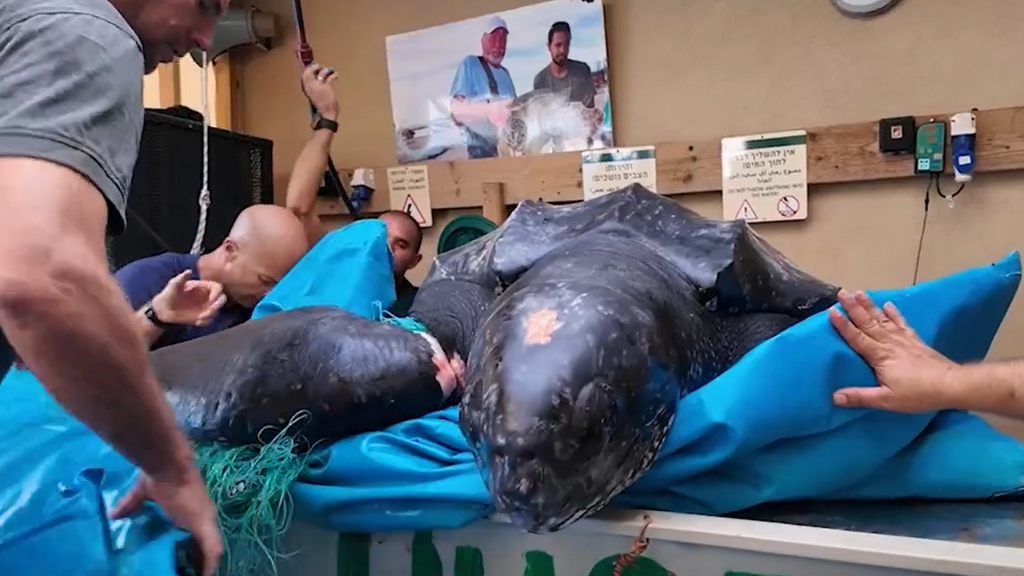A leatherback sea turtle (the largest species of sea turtles) was found at the Tel Dor National Park beach on Wednesday after its left front flipper was amputated and its right front flipper was entangled in a fishing line.
"While walking on the beach, I saw a very large turtle on the rocks in the shallow water. It appeared to be in distress,” said Carol Carmi, a volunteer with the Nature and Parks Authority who discovered the injured turtle. “I noticed that its right flipper was tangled in a fishing line.”
The leatherback sea turtle in Israel
(Video: Erez Erlichman, Nature and Parks Authority)
“As a volunteer with the Nature and Parks Authority who assists at the National Sea Turtle Rescue Center, I knew it was important to get help for it as quickly as possible without touching it,” she added.
“I called the staff at Tel Dor beach, and they contacted the National Sea Turtle Rescue Center in Mikhmoret. I stayed with the turtle and the team until they lifted it onto a cart and took it for further treatment. It was very emotional and unique to encounter such a turtle."
The turtle, estimated to weigh around 300 kg (660 lbs) and measuring about 2 meters (6.5 feet) in length, was brought to the National Sea Turtle Rescue Center operated by the Nature and Parks Authority, where it is receiving medical treatment.
"Before we can remove the fishing line from the turtle's front flipper, the turtle will receive antibiotics," explained Rotem Sadeh, a marine area manager and inspector for the Nature and Parks Authority’s northern region division.
"When the fishing line is released, toxins will enter the turtle’s bloodstream from the flipper, so it's very important not to remove the line before administering antibiotics. Many well-meaning citizens try to remove fishing lines from sea turtles to help them, but it’s actually very dangerous. We were fortunate that Carol, the volunteer who found the turtle, knew exactly what to do."
"It’s quite rare and very exciting to see a leatherback sea turtle on our shores,” National Sea Turtle Rescue Center Director Yaniv Levy added. “Our center has all of the necessary conditions and equipment to help it. We provide supportive care, but most of the rehabilitation is done by the turtles themselves.”
“They’re incredibly resilient creatures that know how to heal. We'll treat the turtle with the goal of returning it to the wild as soon as possible since this giant marine reptile lives in deep waters and its ability to recover is better in nature than in captivity." The turtle was named Dor, a name chosen by Coral.
The last time the rescue center encountered this species on Israel’s shores was in 2022, after a turtle’s corpse was found on the beach, also entangled in fishing gear. The turtle, whose habitat is in the Atlantic Ocean, has been sighted in Israel only 35 times in 70 years since documentation began.
2 View gallery


Some of the fishing equipment which injured the turtle
(Photo: Erez Erlichman, Nature and Parks Authority)
Unfortunately, leatherback turtles have been observed in Israel having been washed ashore after their death. The leatherback sea turtle (Dermochelys coriacea) is considered one of the largest sea turtles in the world, reaching weights of between 300 and 500 kilograms (660-1,100 lbs) each. Despite their heavy weight, they’re known to be fast swimmers and usually live in open ocean areas.
Leatherback turtles feed on algae, but their favorite food is jellyfish, which also presents a significant threat to their survival. Leatherback turtles often mistake plastic bags in the sea for jellyfish, leading to fatal suffocation.
Like other species of marine reptiles, such as the loggerhead and green sea turtles, leatherback turtles face many threats in the wild, including illegal poaching, the looting of nests on beaches, deforestation of tropical areas near their nesting sites, deadly encounters with boats and fishing nets and marine pollution — primarily from plastic waste.
These combined factors have severely impacted the rare species, and it is now classified as critically endangered the most severe animal endangerment category.
Get the Ynetnews app on your smartphone:




